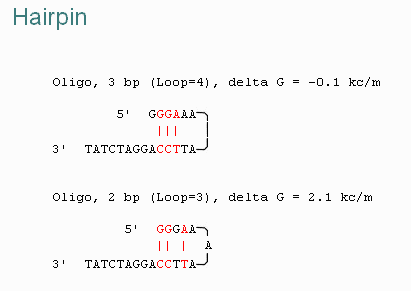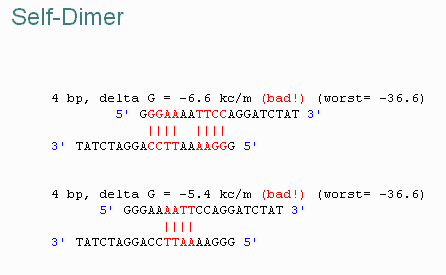What is a primer?
A primer is a short synthetic oligonucleotide which is used in many molecular techniques from PCR to DNA sequencing. These primers are designed to have a sequence which is the reverse complement of a region of template or target DNA to which we wish the primer to anneal.
When designing primers for PCR, sequencing or mutagenesis it is often necessary to make predictions about these primers, for example melting temperature (Tm) and propensity to form dimers with itself or other primers in the reaction. The following program will perform these calculations on any primer sequence or pair.
IDT DNA (Select Oligo Analyzer)
The programs will calculate both the Tm of the primers, as well as any undesireable pairings of primers. When primers form hairpin loops or dimers less primer is available for the desired reaction. For example...
 |
 |
Some thoughts on designing primers.
1. primers should be 17-28 bases in length;
2. base composition should be 50-60% (G+C);
3. primers should end (3') in a G or C, or CG or GC: this prevents "breathing" of ends and increases efficiency of priming;
4. Tms between 55-80oC are preferred;
5. 3'-ends of primers should not be complementary (ie. base pair), as otherwise primer dimers will be synthesised preferentially to any other product;
6. primer self-complementarity (ability to form 2o structures such as hairpins) should be avoided;
7. runs of three or more Cs or Gs at the 3'-ends of primers may promote mispriming at G or C-rich sequences (because of stability of annealing), and should be avoided.
(adapted from Innis and Gelfand,1991)
Also keep in mind that most oligonucleotide synthesis reactions are only 98% efficient. This means that each time a base is added, only 98% of the oligos will receive the base. This is not often critical with shorter oligos, but as length increases, so does the probability that a primer will be missing a base. This is very important in mutagenesis or cloning reactions. Purification by HPLC or PAGE is recommended in some cases.
| Oligonucleotide length | Percent with correct sequence |
| 10 bases | (0.98)10 = 81.7% |
| 20 bases | (0.98)20 = 66.7% |
| 30 bases | (0.98)30 = 54.6% |
| 40 bases | (0.98)40 = 44.6% |
Designing Degenerate Oligonucleotides.
A group of degenerate oligonucleotides contain related sequences with differences at specific locations. These are used simultaneously in the hope that one of the sequences of the oligonucleotides will be perfectly complementary to a target DNA sequence.
One common use of degenerate oligonucleotides is when the amino acid sequence of a protein is known. One can reverse translate this sequence to determine all of the possible nucleotide sequences that could encode that amino acid sequence. A set of degenerate oligonucleotides would then be produced matching those DNA sequences. The following link will take you to a program that will perform a reverse translation. http://arbl.cvmbs.colostate.edu/molkit/rtranslate/
For example, the amino acid sequence shown in purple below could be encoded by the following codons.
AspGluGlyPheLeuSerTyrCysTrpLeuProHisGln
GATGAAGGTTTTCTTTCTTATTGTTGGCTTCCTCATCAA
C G C CT CAGC C C T C C C G
A A A A A
G G G G G
One could then select the 14 base sequence (in blue) to generate a smaller set of degenerate oligonucleotides. Each oligonucleotide in the set would have one base changed at a time (shown in purple below). A total of 32 unique oligonucleotides would be generated.
TATTGTTGGCTTCC
TACTGTTGGCTTCC
TATTGCTGGCTTCC
TACTGCTGGCTTCC
etc.
When ordering degenerate oligonucleotides, you just let the company know that you want a mixture of nucleotides added at a specific position using the code below. By adding the mixture, oligos will incorporate one of the bases, leading to a mixture of oligonucleotides.
Standard MixBase Definitions A, G C, T A, C G, T C, G A, T A, C, T C, G, T A, C, G A, G, T A, C, G, T
| Design primers 15-25 bp long that will amplify both of the sequences below. You may wish to use an Alignment program to identify conserved regions in both sequences. These sites would be good targets for PCR primers to bind to both sequences. Recall that the two primers need to bind to the target DNA such that the free 3´ ends of each primer point towards each other. You may wish to review the rules used design primers. After you have identified the sequence of your primers, check the primers with the programs used to calculate melting temperature (Tm) and the formation of primer dimers. If the Tm is less than 55oC or bad hairpins or dimers form, try another region of sequence. A link to one possible answer is given at the bottom of the page. >Paddlefish CCTTGGCCTCTGCCTAATCACACAGATTCTAACAGGATTATTTCTCGCAATACACTACACAGCTGACA TCTCAACAGCCTTCTCCTCCGTCGCCCACATCTGTCGAGATGTTAACTACGGATGACTAATTCGAAAC ATTCATGCAAACGGAGCCTCCTTTTTCTTCATCTGCCTCTACCTTCACGTAGCCCGAGGCATATACTA TGGCTCATACCTCTACAAAGAAACCTGAAACATCGGAGTAGTTCTCCTACTCCTAACTATAATAACCG CCTTCGTAGGATATGTGCTCCCATGAGGACAGATATCCTTCTGAGGAGCCACCGTAATTACCAACCTT CTTTCCGCCTTCCCCTACATCGGGGACACCCTAGTACAATGAATCTGAGGTGGTTTCTCAGTAGACAA CGCCACCCTAACC >Shovenose Sturgeon CCTAGGCCTCTGCCTTATTACACAAATCTTAACAGGACTATTTCTTGCAATACACTACACAGCTGACA TTTCAACAGCCTTCTCCTCCGTCGCCCACATCTGCCGAGACGTAAACTACGGGTGACTAATCCGAAAC GTCCACGCAAATGGCGCCTCCTTCTTCTTTATCTGCTTGTACCTTCACGTCGCACGAGGTATATACTA CGGCTCCTACCTCCAAAAAGAAACCTGAAACATCGGAGTAGTCCTCTTACTCCTCACCATAATAACCG CCTTCGTAGGCTATGTACTGCCCTGAGGACAAATATCATTTTGAGGGGCAACCGTAATCACTAACCTC CTTTCCGCCTTCCCGTACATCGGCGACACATTAGTGCAATGAATCTGAGGCGGCTTTTCAGTC |
| Upon aligning the two sequences you would get the results below. A vertical line indicates that the base is conserved in the two sequences, the absence of a line indicates a change. This makes it easy to identify conserved regions which would be good sites for a primer to bind to both sequences. There are many possible answers to this problem. The two below are not necessarily the best, try several primer sequences to see which work best. The sequence ccttggcctctgcct would make a good first primer. There is only one mis-match. However, it only has a Tm of 54oC and forms a hairpin and dimers. Instead, the sequence gccttctcctccgtcgccc is 74% GC with a Tm of 63oC and doesn´t form hairpins or dimers. This would be a better primer, but the PCR product would be about 100 bp shorter. This would make a decent Primer 1. Similarly the sequence cgatgtaggggaaggcggaaag is 59% GC with a Tm of 61oC and doesn´t form hairpins or dimers. This would make a good Primer 2.
| |||
| Query: 1 ccttggcctctgcctaatcacacagattctaacaggattatttctcgcaatacactacac 60 Primer 1 5´gccttctcctccgtcgccc 3´ Primer 2 3´gaaaggcggaaggggatgta |
| Purpose: to use a database to design specific PCR primers to amplify a region of DNA. Go to Biology Workbench and log in. Select Session Tools and then New Session. Name the New Session Deer Bone Next select Nucleic Tools and then Ndjinn (this is a search engine for DNA and protein sequences) In the search window enter the following three ascession numbers separated by "or" AF016978 OVU12869 BBU12864 Next scroll down and click the box next to the term GBMAM (GenBank Mammal) When the three sequences appear, select Import Sequences These three sequences will now be imported into your Deer Bone folder. What region of DNA do these sequences correspond to? From which species? Click on the boxes next to each sequence file and then select CLUSTALW This program will align the three sequences.
Your assignment is to use this aligned sequence to design PCR primers which will amplify all three DNAs. The Tm of the primers should be >50C. Also design the primers such that the PCR products from the two different species will be different sizes. This will allow for rapid identification of the species. To check the Tm of primers use the program on the page PRIMER DESIGN in BioWeb.
To be turned in for credit: qPrint out the report for the two primers you end up choosing, showing the Tm, length, etc. qTurn in a printout of the aligned sequences with the location of the two primers indicated. qWhat sized PCR product will you generate in each species? |



No comments:
Post a Comment